engineering 2023 | prelims
1/165
There's no tags or description
Looks like no tags are added yet.
Name | Mastery | Learn | Test | Matching | Spaced |
|---|
No study sessions yet.
166 Terms
moment and couple (formula)
M=Fd
concurrent
all acting through the same point
friction (definition)
the resistance to motion of two bodies in contact
coefficient of friction (definition)
the ratio of the frictional force present and the normal reaction of the two surfaces in contact
friction (formula)
F=μN
influences on friction
mass/normal reaction
type of material
pascal’s principle
the liquid spreads to fill up to the edges of a container
the increase in pressure is evenly spread through the liquid
a small force (in a small container) can be turned into a larger force (in a larger container)
shear stress
the tendency to cause deformation along the planes parallel to the imposed stress
liquids and shear stress
cannot support shear stress
deform and take the shape of the container
solids and shear stress
may deform elastically, but generally maintain a fixed form and volume
hydrostatic pressure applications
hydraulic braking systems → use hydraulics to amplify the force applied on the brake pedal to clamp the discs to stop the wheels
work (definition)
occurs when a force causes motion
forces do work
measured in joules (J)
work (formula)
W=Fs
energy (definition)
the measure of it’s capacity to do work
types of energy
mechanical, potential, kinetic, chemical, electrical, heat, atomic
potential energy
a measure of the object’s ability to do work due to a specific position
kinetic energy
energy an object possesses due to motion
amount of kinetic energy a body possesses = the amount of work required to bring it to rest
law of conservation of energy
energy can be neither destroyed nor created, rather transformed from one form to another
power (definition)
the rate at which work is done
measured in watts (W)
6 types of simple machines
lever, screw, wedge, inclined plane, pulley, wheel and axle
lever
consists of a rigid bar that rotates around a fulcrum
applying one force on one end amplifies the output force
examples of levers
scissor, wheelbarrow, hammer
inclined plane
sloping surface that allows the movement of an object up/down
examples of inclined planes
ramp, slide, roof, funnel
wheel and axle
consists of a circular wheel attached to a shaft (axle)
when force is applied to the wheel, the axle rotates
examples of wheel and axles
bicycle, doorknob
wedge
used to split or hold objects in place
consists of a sharp pointed edge
examples of wedges
shovel, zipper, knife
screw
an inclined plane wrapped around a cylindrical post
when rotated, moves through solid material
useful for holding objects together or lifting them
examples of screws
lightbulbs, corkscrew
pulley
a wheel with a groove to hold.a rope
pulling one end allows the lifting of objects vertically
examples of pulleys
elevator, flagpole
1st order lever
fulcrum in the middle
MA and VR >, <, = to 1
2nd order lever
load in the middle
MA and VR > 1
3rd order lever
effort in the middle
MA and VR < 1
1st order levers in the body
neck muscles to keep your head up
triceps when pulling a load
2nd order levers in the body
lifting your heel up
3d order levers
biceps when holding an object
mechanical advantage (definition)
a measure of the benefit in using simple machines (usually levers)
the higher the MA, the more efficient
MA (formula)
MA = load/effort
mechanical disadvantage
E > L
what does it mean if the fulcrum is closer to the load
less effort needed
velocity ratio (defintion)
the ratio of the distance moved by the effort compared with the distance moved by the load
the higher the VR, the greater distance the user must move
VR (formula)
VR = length of effort arm / length of load arm
finding the VR in pulleys
count the number of ropes excluding the load rope
efficiency (formula)
η = MA/VR
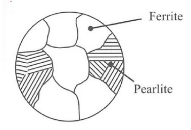
hypo-eutectoid steel
hypo-eutectoid steel (carbon)
0.2%
hypo-eutectoid (properties)
high ductility, malleability and weldability
what happens when carbon content in steel increases?
strength and hardness increases
ductility and weldability decrease

eutectoid steel
eutectoid steel (carbon)
0.8%
eutectoid steel (properties)
good toughness and high tensile strength
high production

hyper-eutectoid steel
hyper-eutectoid steel (carbon)
1.2%
hyper-eutectoid (properties)
good wear resistance, toughness and hardness
austenitestructure
FCC
denoted as solid grey sections
austenite
forms when liquid steel first starts to cool
does not exist below 723 degrees
dissolves up to 2% carbon
ferrite structure
BCC
denoted by white sections
ferrite
as the steel cools, the austenite will turn into ferrite
very small amount of carbon (0.025%)
ferrite properties
soft and ductile
cementite structure
ferrite doesn’t absorb much carbon, so the rest of the carbon joins with the remaining iron to form cementite
denoted by solid black cracks
cementite properties
hard and brittle
increases the hardness of the steel
lowered ductility and toughness
pearlite structure
layers of ferrite and cementite
a lamellar structure (layered)
denoted by striped sections
pearlite properties
hard and strong
not tough
order of steel formation
austenite, ferrite, pearlite, cementite
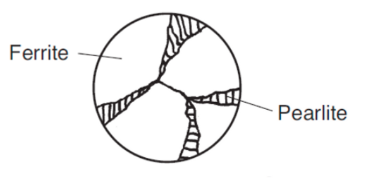
dead mild steel
dead mild steel (carbon)
0.07 - 0.15%
dead mild steel (properties)
highly ductile and elleable
capable of withstanding a large amount of cold working
dead mild steel (uses)
chains, revets, wire, nails
used in production of solid tubes where cold deformation is required
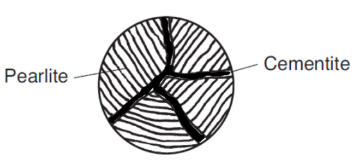
high carbon steels
high carbon steels (carbon)
0.55 - 0.9%
high carbon steels (properties)
high strength
high wear resistance
high carbon steels (uses)
saws, drills, high-tensile tubes
chisels, hammers
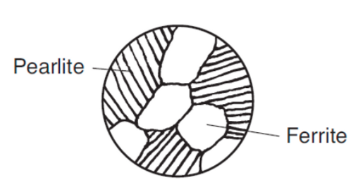
mild steels
mild steels (carbon)
0.15 - 0.25%
mild steels (properties)
very weldable
does not harden when quenched
mild steels (uses)
most common type of steel
structural steels, screws, machine parts, car bodies, gears, shafts, levers
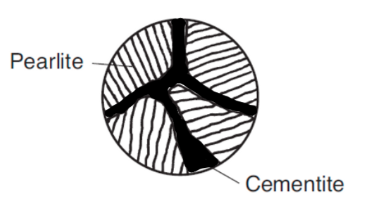
tool steels (ultra high steels)
tool steels (carbon)
0.9 - 1.6%
tool steel (properties)
high tensile strength
excellent wear resistance and hardness
tool steel (uses)
drills, taps, knives, files, wires, axes

medium carbon steels
medium carbon steels (carbon)
0.25 - 0.55%
medium carbon steels (properties)
good tensile strength
medium carbon steel (uses)
connecting rods, shafts, axles, springs, wire ropes
martensitic steel (structure)
forms in steels when steel is quenched form an austenite structure
martensitic steel (properties)
high hardness and tensile strength
less corrosion resistion
martensitic steel (uses)
cutlery, surgical instruments, wrenches
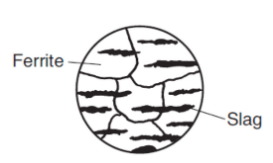
wrought iron
wrought iron (carbon)
less than 0.1% carbon
1-2% slag
mix of silicon, sulphur and metal oxides
slag (definition)
waste left over when pure iron is extracted from its ore
wrought iron properties
tough but malleable
ductile, easy to weld and resistant to corrosion
has a unique grain appearance when broekn open, from the slag peices
wrought iron (uses)
has been widely replaced by steel, as mordern iron is more stronger
remains only for use in ornamental ironwork
used be be used in horseshoes and railways
wrought iron (manufacture)
it is worked into shape rather than being poured into a mould like cast iron
cast iron vs wrought iron
- wrought iron is more corrosion resistance
- cast iron is less malleable and more brittle
- wrought iron is worked with tools, cast iron is melted an casted
cast iron vs steel
- cast iron has more carbon than steels
what happens as carbon content in steel increases?
strength and hardness increase
ductility and weldability decrease
cast iron (carbon)
2-4%
why is cast iron a desirable engineering material?
relatively cheap
high compressive strength and rigidity
easily machined
good fluidity, flows wwell in castings